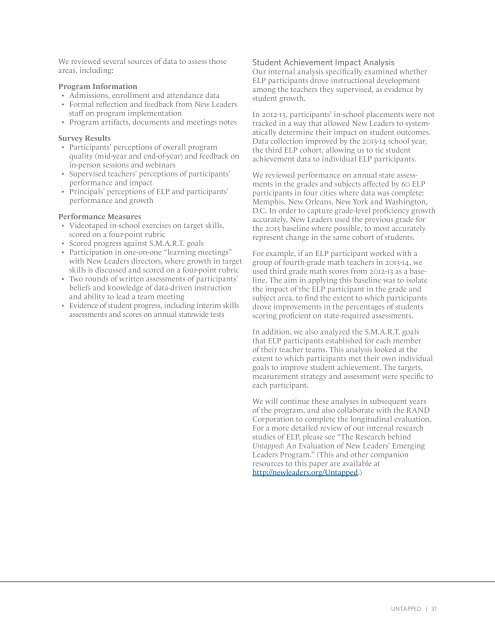NewLeaders_Untapped
NewLeaders_Untapped
NewLeaders_Untapped
You also want an ePaper? Increase the reach of your titles
YUMPU automatically turns print PDFs into web optimized ePapers that Google loves.
We reviewed several sources of data to assess thoseareas, including:Program Information• Admissions, enrollment and attendance data• Formal reflection and feedback from New Leadersstaff on program implementation• Program artifacts, documents and meetings notesSurvey Results• Participants’ perceptions of overall programquality (mid-year and end-of-year) and feedback onin-person sessions and webinars• Supervised teachers’ perceptions of participants’performance and impact• Principals’ perceptions of ELP and participants’performance and growthPerformance Measures• Videotaped in-school exercises on target skills,scored on a four-point rubric• Scored progress against S.M.A.R.T. goals• Participation in one-on-one “learning meetings”with New Leaders directors, where growth in targetskills is discussed and scored on a four-point rubric• Two rounds of written assessments of participants’beliefs and knowledge of data-driven instructionand ability to lead a team meeting• Evidence of student progress, including interim skillsassessments and scores on annual statewide testsStudent Achievement Impact AnalysisOur internal analysis specifically examined whetherELP participants drove instructional developmentamong the teachers they supervised, as evidence bystudent growth.In 2012-13, participants’ in-school placements were nottracked in a way that allowed New Leaders to systematicallydetermine their impact on student outcomes.Data collection improved by the 2013-14 school year,the third ELP cohort, allowing us to tie studentachievement data to individual ELP participants.We reviewed performance on annual state assessmentsin the grades and subjects affected by 60 ELPparticipants in four cities where data was complete:Memphis, New Orleans, New York and Washington,D.C. In order to capture grade-level proficiency growthaccurately, New Leaders used the previous grade forthe 2013 baseline where possible, to most accuratelyrepresent change in the same cohort of students.For example, if an ELP participant worked with agroup of fourth-grade math teachers in 2013-14, weused third grade math scores from 2012-13 as a baseline.The aim in applying this baseline was to isolatethe impact of the ELP participant in the grade andsubject area, to find the extent to which participantsdrove improvements in the percentages of studentsscoring proficient on state-required assessments.In addition, we also analyzed the S.M.A.R.T. goalsthat ELP participants established for each memberof their teacher teams. This analysis looked at theextent to which participants met their own individualgoals to improve student achievement. The targets,measurement strategy and assessment were specific toeach participant.We will continue these analyses in subsequent yearsof the program, and also collaborate with the RANDCorporation to complete the longitudinal evaluation.For a more detailed review of our internal researchstudies of ELP, please see “The Research behind<strong>Untapped</strong>: An Evaluation of New Leaders’ EmergingLeaders Program.” (This and other companionresources to this paper are available athttp://newleaders.org/<strong>Untapped</strong>.)UNTAPPED | 31


